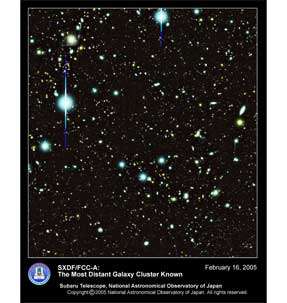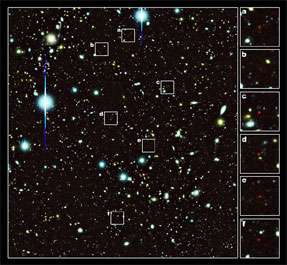Galaxy Clusters Formed Early

Only one billion years after the Big Bang, clusters of galaxies were already forming. This discovery pushes back the age of the youngest known galaxy cluster by a third, and shows that the largest astronomical objects in the Universe had already begun to form in one of the earliest epochs of the Universe that astronomers have been able to observe. This work was conducted by researchers from the University of Tokyo, the National Astronomical Observatory of Japan, and elsewhere using the Subaru telescope.
Galaxies often congregate to form clusters of galaxies. At the present day, clusters have tens and hundreds of member galaxies and are the largest astronomical objects in the Universe. Knowing how they formed is a key to understanding the past and future of the Universe.
To study how the Universe has changed over large scales in space and time, it is essential to observe deeply a wide area of the sky. A large number of researchers are now studying the Subaru-XMM Deep Survey Field (SXDS), an approximately one square degree area of the sky in the direction of the constellation Cetus, the Whale, at many wavelengths using several telescopes.
To understand the origin of galaxy clusters, Masami Ouchi, currently at the Space Telescope Science Institute, decided to study how galaxies approximately 12.7 billion light years away (a red shift of 5.7) were distributed in the SXDS. By using the color of galaxies as a guide to their distance, Ouchi and his collaborators found 515 galaxies in a volume 500 million light years in height and width and 100 million light years in depth in images from Subaru's prime focus camera (Suprime-Cam).
Figure 1 shows a density map of the galaxies in this volume as seen on the sky. This map represents the physical structures in the Universe at the farthest distances and the earliest times that astronomers have been able to observe to date. The yellow regions are where there are the highest concentration of galaxies.
In the bottom portion of this map, the researchers found a concentration of galaxies that could not be explained by chance. By obtaining accurate distance estimates to these galaxies using Subaru's Faint Object Camera and Spectrograph (FOCAS), the researchers confirmed that there were six galaxies concentrated in a small volume only 3 million light years in diameter, forming a galaxy cluster. Figure 2 identifies the six member galaxies of the cluster.
The cluster has several properties that reveal its young age. It is one hundred times less massive than present day galaxy clusters and has significantly fewer members. Moreover, its member galaxies are producing stars at one hundred times the rate of galaxies outside the cluster.

The infant galaxy cluster existed at a time when the Universe was only one billion years old. The youngest portraits of galaxy clusters that astronomers previously had were from the Universe at an age of one and a half billion years. As any parent would attest, young children change rapidly. The portrait of a galaxy cluster at a younger age fills a significant gap in our knowledge of the early history of the Universe when stars, galaxies, and clusters were first forming.
"The fact that a cluster is already forming so soon after the Big Bang puts strong constraints on the fundamental structure of the Universe", says Ouchi. The prevailing theory of cosmology postulates that smaller mass structures form first and then grow into more massive structures. "Our results seem to contradict the prevailing wisdom, but the real challenge is in understanding how well the distribution of visible matter such as galaxies correlates with the distribution of mass in general. As we continue to fill in the gaps in the early history of clusters, we should be able to resolve such ambiguities", he says.
These results were published in the February 10, 2005, edition of the Astrophysical Journal (ApJ 620, L1-L4) and will be presented at the meeting "The Future of cosmology with clusters of Galaxies" beginning on February 26, 2005, in Waikoloa, Hawaii.
















